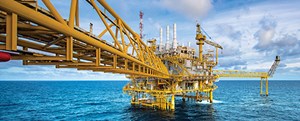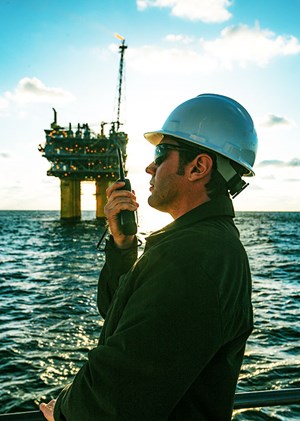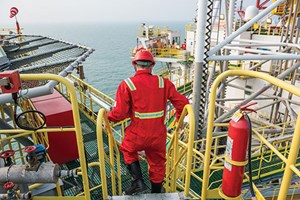Safety first, safety always: COS supports offshore safety and environmental management systems
For more than a decade, the Center for Offshore Safety (COS) has supported continuous improvement in Safety and Environmental Management Systems (SEMS) in offshore operations on the U.S. outer continental shelf.
Established by industry in the wake of the Deepwater Horizon incident, the American Petroleum Institute (API) administered COS promotes safety for offshore exploration and production through leadership, effective SEMS implementation, and collecting safety and incident data to support the continuous improvement of SEMS.

COS key objectives. The work of COS is based on API Recommended Practice (RP) 75, Safety and Environmental Management System for Offshore Operations and Assets. Now in its 4th edition, API RP 75 provides guidance for establishing, implementing, maintaining and continually improving SEMS for offshore natural gas and oil operations. While previous editions of RP 75 were tailored to production operations in the Gulf of Mexico, the latest edition, published in 2019, expands the reach of SEMS internationally and may be used by contractors and subcontractors, Fig. 1. The 4th edition also incorporates the latest advancements in technology and risk management.
In addition to providing tools, peer learning opportunities, good practices and support for offshore operators, COS collects, analyzes and publishes annual safety performance data from its members to help the industry drive improvements in safety and environmental performance. The data help to shape and inform what COS and industry should focus on, resulting in good practice guidance documents, based on safety developments and offshore trends.
“The annual performance report and its detailed data demonstrate member companies’ commitment to transparency. The only way we’re going to be able to learn is to talk about what’s working well and what’s not working well. If we truly want to learn and continuously improve, we need to be able to share all of it,” said Russell Holmes, senior director of COS.
Safety bulletins. COS facilitates knowledge sharing and learning among member companies to support the continuous improvement of their SEMS. One way this is done is through Safety Shares to communicate with offshore operators on issues ranging from incidents of dropped objects to mechanical lifting. These one-page incident reports delve into the details of incidents and near-misses, as well as lessons learned. They are intended to prompt discussions among offshore workers on how similar incidents can be avoided.

“Sharing knowledge and good practices across the industry is critical, so that operators can learn from each other to enhance operational safety and continuously improve SEMS,” said Holmes. “We’re taking aspects of different companies’ programs, and kind of trying to merge them all together into guidance documents, so that a large or small operator could take that information and then tailor their program, based on some of that information.” Continuous improvements through learning, collaborating and innovating have helped make offshore natural gas and oil exploration and production on the U.S. outer continental shelf the safest it’s ever been, he added.
SEMS certificates. COS coordinates with the U.S. Coast Guard and Bureau of Safety and Environmental Enforcement (BSEE), highlighting how industry, government and other stakeholders can collaborate to enhance safety and operational integrity. COS promotes the development of a strong safety culture, based on six characteristics from BSEE’s Culture Policy Statement: 1) leadership; 2) respect and trust; 3) ensure a safe environment for raising concerns; 4) open communication; 5) personal accountability; and 6) an inquiring attitude. The third edition of API RP 75 is incorporated into BSEE regulatory requirements. BSEE regulations require that offshore operators implement SEMS and have their SEMS audited by an independently accredited auditing firm.
COS is the only organization that is recognized by the federal government to accredit an audit service provider to audit SEMS. As the accreditation body for third-party audit service providers, COS provides a portal for auditing firms that are accredited or that wish to become accredited to perform SEMS audits. COS provides the list of COS-accredited organizations, which conduct BSEE required SEMS audits, and issue certificates pursuant to third-party requirements for SEMS auditing and certification. Currently, there are five COS-accredited audit service providers allowed to do SEMS audits of U.S. outer continental shelf operators.
Dozens of COS members—including operating companies, drilling contractors and energy services firms—have obtained and maintained SEMS certificates, demonstrating the industry’s drive to achieve the highest standards for safety and environmental protection. In all, COS represents about 75% of the offshore industry from a workforce hours perspective, Fig. 2.
Expanding COS participation. To foster sharing and reach a larger portion of the offshore industry, COS adjusted its membership model last year. Previously, API members had to pay separate dues to join COS. Under the recent changes, API members with an interest in the U.S. outer continental shelf can now participate in COS without paying additional dues. Also, the dues for non-API members to join COS were reduced to $5,000 per year. “We want to be able to reach a larger portion of the offshore industry, so that operators can learn from incidents and truly share lessons learned that can be implemented across the industry,” Holmes said.

Events and webinars. COS hosts an annual Safety Forum every fall that has become one of the must-attend, safety-focused events for industry, auditors and regulatory agency engagement. The COS Forum brings together offshore industry operators, drilling contractors, service/supply companies, academia and regulators to facilitate collaboration and drive continuous improvement. The next COS Forum will be held Sept. 13, 2022, in Houston, Texas.
COS also hosts an annual session, focused on health, safety and environmental management at the Offshore Technology Conference. Prompted by in-person limitations during the Covid-19 pandemic, COS began hosting webinars to highlight publications, guidance, documents and various other issues of importance. COS is represented at various industry events throughout the year, such as the API Offshore Safe Lifting Conference & Expo and the Hurricane Season Workshop.
API standards improve safety culture. The natural gas and oil industry strives to integrate safety into every operational process. This focus has led to advancements in technology, improved industry standards and enhanced best practices, and better regulations in addition to innovative approaches to addressing offshore safety. As the world’s premier standards setting organization for the oil and gas industry, API has developed more than 800 rigorous standards that enhance safety, operations and environmental protection across virtually every segment of the industry. Some 275 API standards are related to offshore natural gas and oil operations, covering fixed offshore platforms, drilling operations, floating production systems, subsea equipment and much more.
“The industry has been producing offshore for decades, allowing for continuous improvement through learning, collaborating and innovating that has enhanced operating standards to improve safety,” said Anchal Liddar, senior vice president of API’s Global Industry Services. “API standards and programs, such as COS, help the industry meet its core values of safety, environmental stewardship and mitigation of incidents.”
- Advancing offshore decarbonization through electrification of FPSOs (March 2024)
- The last barrel (February 2024)
- Oil and gas in the Capitals (February 2024)
- What's new in production (February 2024)
- First oil (February 2024)
- Subsea technology- Corrosion monitoring: From failure to success (February 2024)


